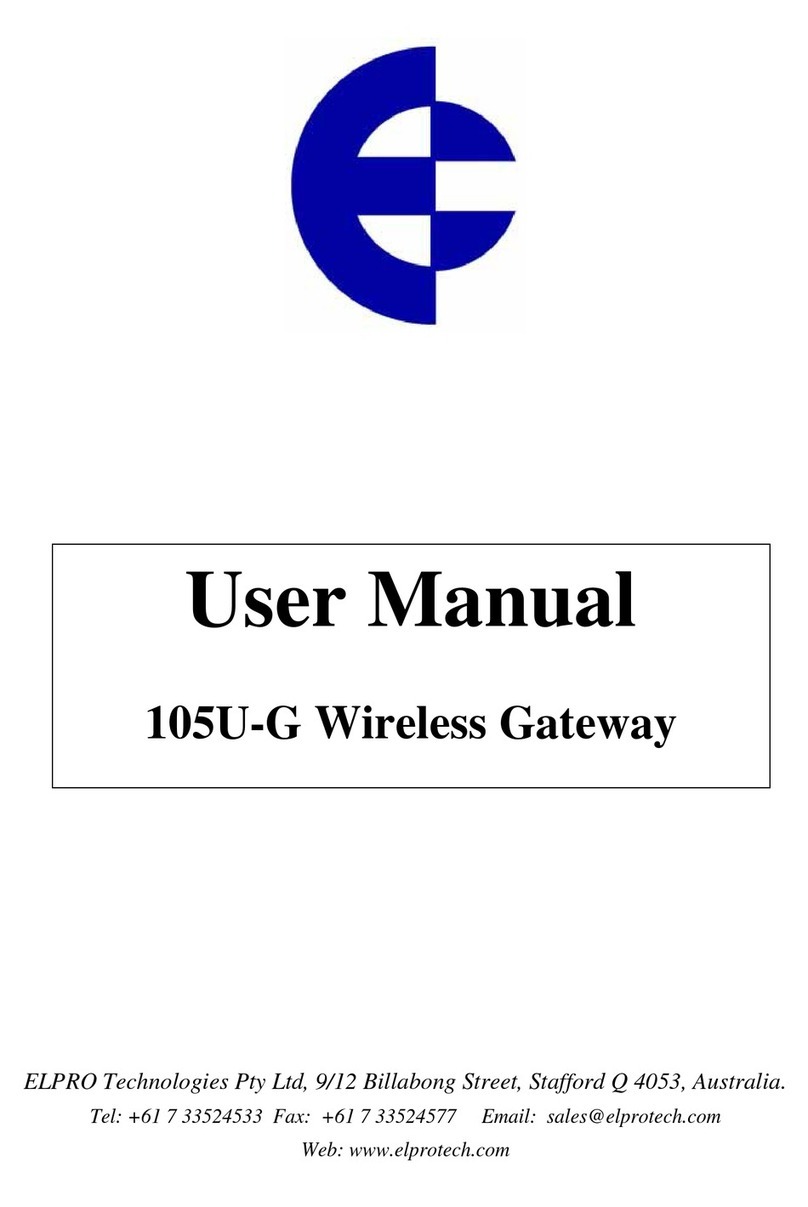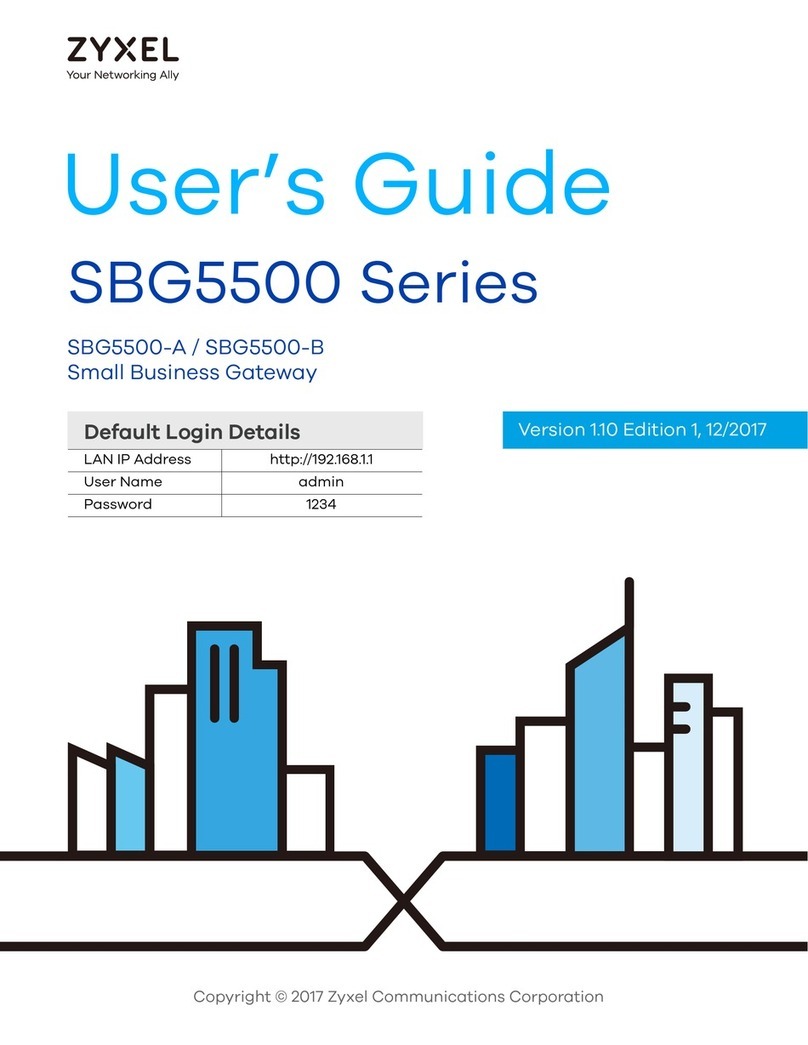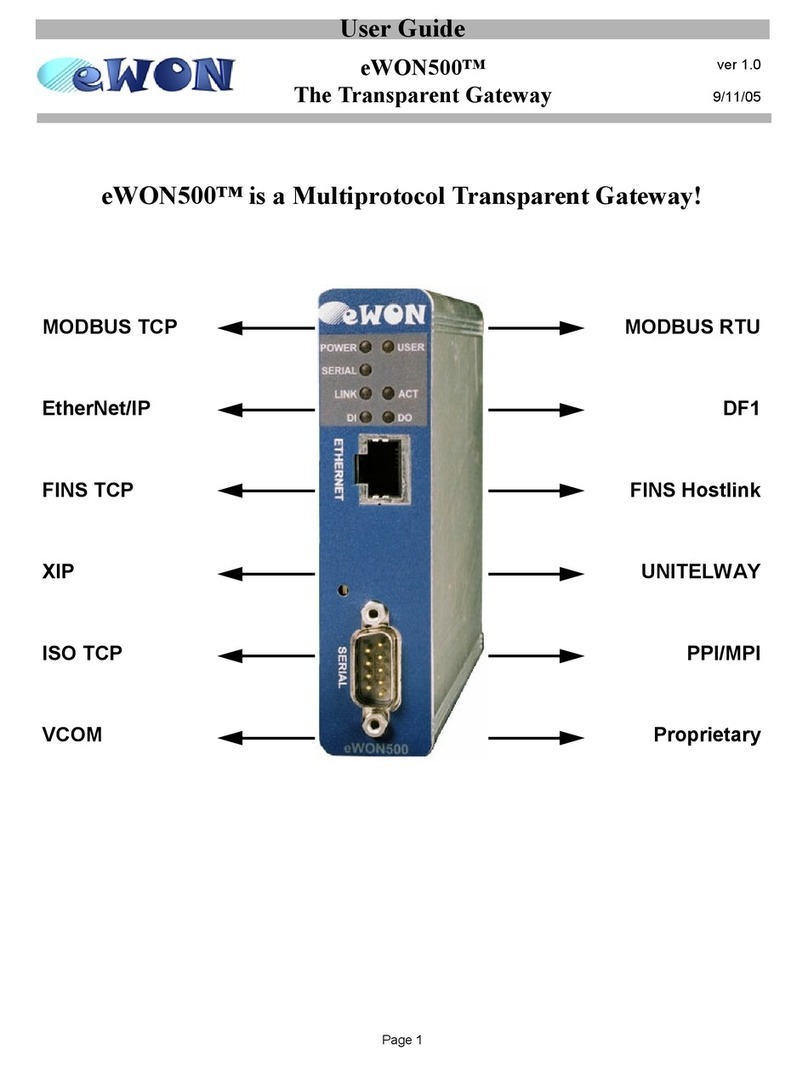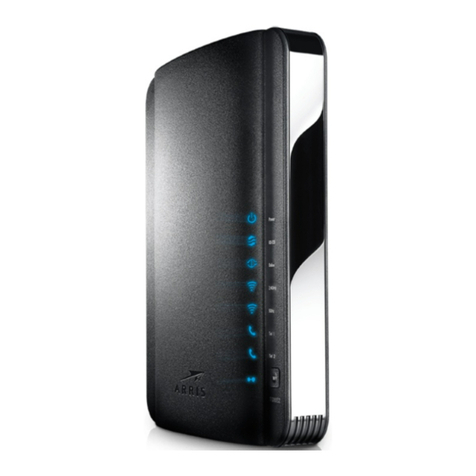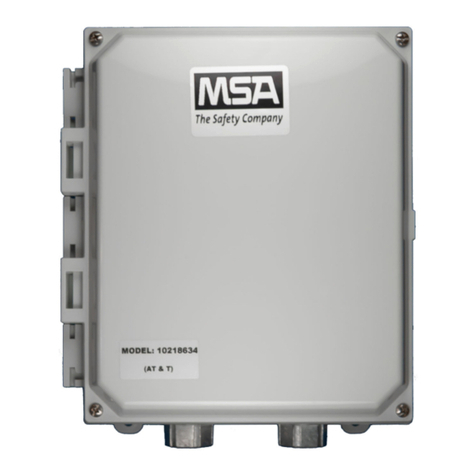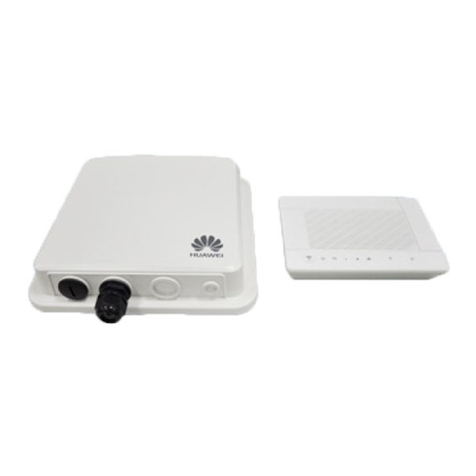Elpro Technologies 905U-G User manual

ELPRO Technologies Pty Ltd, 9/12 Billabong Street, Stafford Q 4053, Australia.
Web: www.elprotech.com
User Manual
905U-G Wireless Gateway

Important Notices
MAN_905G_1.16 Page 2
Thank you for your selection of the 905G module. We trust it will give you many
years of valuable service.
ATTENTION!
Incorrect termination of supply wires may
cause internal damage and will void warranty.
To ensure your 905G enjoys a long life,
double check ALL your connections with
the user’s manual
before turning the power on.
Caution!
For continued protection against risk of fire, replace the module fuse F1 only with
the same type and rating.
CAUTION:
To comply with FCC RF Exposure requirements in section 1.1310 of the FCC Rules, antennas
used with this device must be installed to provide a separation distance of at least 20 cm from
all persons to satisfy RF exposure compliance.
DO NOT:
•operate the transmitter when someone is within 20 cm of the antenna
•operate the transmitter unless all RF connectors are secure and any open connectors are
properly terminated.
•operate the equipment near electrical blasting caps or in an explosive atmosphere
All equipment must be properly grounded for safe operations. All equipment should be serviced
only by a qualified technician.

905U-G Wireless Gateway User Manual
Page 3©September 2004
FCC Notice:
This user’s manual is for the ELPRO 905U-G radio telemetry module. This device complies with
Part 15.247 of the FCC Rules.
Operation is subject to the following two conditions:
1) This device may not cause harmful interference and
2) This device must accept any interference received, including interference that may cause
undesired operation.
This device must be operated as supplied by ELPRO Technologies Pty Ltd. Any changes or
modifications made to the device without the written consent of ELPRO Technologies Pty. Ltd.
May void the user’s authority to operate the device.
End user products that have this device embedded must be supplied with non-standard antenna
connectors, and antennas available from vendors specified by ELPRO Technologies. Please
contact ELPRO Technologies for end user antenna and connector recommendations.
Notices: Safety
Exposure to RF energy is an important safety consideration. The FCC has adopted a safety
standard for human exposure to radio frequency electromagnetic energy emitted by FCC regulated
equipment as a result of its actions in Docket 93-62 and OET Bulletin 65 Edition 97-01.
CAUTION:
To comply with FCC RF Exposure requirements in section 1.1310 of the FCC Rules, antennas
used with this device must be installed to provide a separation distance of at least 20 cm from all
persons to satisfy RF exposure compliance.
DO NOT:
•operate the transmitter when someone is within 20 cm of the antenna
•operate the transmitter unless all RF connectors are secure and any open connectors are
properly terminated.
•operate the equipment near electrical blasting caps or in an explosive atmosphere
All equipment must be properly grounded for safe operations. All equipment should be serviced
only by a qualified technician.

Important Notices
MAN_905G_1.16 Page 4
Important Notice
ELPRO products are designed to be used in industrial environments, by experienced industrial
engineering personnel with adequate knowledge of safety design considerations.
ELPRO radio products are used on unprotected license-free radio bands with radio noise and
interference. The products are designed to operate in the presence of noise and interference,
however in an extreme case, radio noise and interference could cause product operation delays or
operation failure. Like all industrial electronic products, ELPRO products can fail in a variety of
modes due to misuse, age, or malfunction. We recommend that users and designers design
systems using design techniques intended to prevent personal injury or damage during product
operation, and provide failure tolerant systems to prevent personal injury or damage in the event
of product failure. Designers must warn users of the equipment or systems if adequate protection
against failure has not been included in the system design. Designers must include this Important
Notice in operating procedures and system manuals.
These products should not be used in non-industrial applications, or life-support systems, without
consulting ELPRO Technologies first.
1. For 905G modules, a radio license is not required in most countries, provided the module
is installed using the aerial and equipment configuration described in the 905U Installation
Guide. Check with your local 905G distributor for further information on regulations.
2. For 905G modules, operation is authorized by the radio frequency regulatory authority in
your country on a non-protection basis. Although all care is taken in the design of these
units, there is no responsibility taken for sources of external interference. The 905U
intelligent communications protocol aims to correct communication errors due to
interference and to retransmit the required output conditions regularly. However some
delay in the operation of outputs may occur during periods of interference. Systems
should be designed to be tolerant of these delays.
3. To avoid the risk of electrocution, the aerial, aerial cable, serial cables and all terminals of
the 905G module should be electrically protected. To provide maximum surge and
lightning protection, the module should be connected to a suitable earth and the aerial,
aerial cable, serial cables and the module should be installed as recommended in the
Installation Guide.
4. To avoid accidents during maintenance or adjustment of remotely controlled equipment,
all equipment should be first disconnected from the 905U module during these
adjustments. Equipment should carry clear markings to indicate remote or automatic
operation. E.g. "This equipment is remotely controlled and may start without warning.
Isolate at the switchboard before attempting adjustments."
5. The 905G module is not suitable for use in explosive environments without additional
protection.

905U-G Wireless Gateway User Manual
Page 5©September 2004
Limited Warranty, Disclaimer and Limitation of
Remedies
ELPRO products are warranted to be free from manufacturing defects for a period of 2 years
from the effective date of purchase. The effective date of purchase is decided solely by
ELPRO Technologies.
This warranty does not extend to:
- failures caused by the operation of the equipment outside the particular product's
specification, or
- use of the module not in accordance with this User Manual, or
- abuse, misuse, neglect or damage by external causes, or
-repairs, alterations, or modifications undertaken other than by an authorized Service
Agent.
ELPRO’s liability under this warranty is limited to the replacement or repair of the product.
This warranty is in lieu of and exclusive of all other warranties. This warranty does not
indemnify the purchaser of products for any consequential claim for damages or loss of
operations or profits and ELPRO is not liable for any consequential damages or loss of
operations or profits resulting from the use of these products. ELPRO is not liable for
damages, losses, costs, injury or harm incurred as a consequence of any representations,
warranties or conditions made by ELPRO or its representatives or by any other party, except as
expressed solely in this document.
How to Use This Manual
To receive the maximum benefit from your 905G product, please read the Introduction,
Installation and Operation chapters of this manual thoroughly before using the 905G.
Chapter Four Configuration explains how to configure the modules using the Configuration
Software available.
Chapter Six Troubleshooting will help if your system has problems.
The foldout sheet 905U-G Installation Guide is an installation drawing appropriate for most
applications.

Contents
MAN_905G_1.16 Page 6
CONTENTS
CHAPTER 1 INTRODUCTION 9
1.1 905G OVERVIEW 9
1.1.1 Modbus / DF1 905G 10
1.1.2 Profibus 905G 10
1.1.3 Ethernet 905G 11
1.1.4 DeviceNet 905G 12
1.1.5 Modbus Plus 905G 12
1.2 THE 905G STRUCTURE 13
1.2.1 On-board I/O 14
1.2.2 I/O Expansion - 105S modules 14
1.3 THE WIRELESS NETWORK 14
1.3.1 905U to 905G Network 14
1.3.2 905G to 905G Network 15
1.3.3 “Data Concentrator” Networks 16
1.3.4 905G Repeaters 17
CHAPTER 2 OPERATION 19
2.1 START-UP 19
2.2 OPERATION 19
2.3 DATABASE 21
2.4 THE HOST - 905G LINK 22
2.4.1 Modbus / DF1 22
2.4.2 Profibus 23
2.4.3 Ethernet 23
2.5 RADIO SYSTEM DESIGN 23
2.5.1 Radio Signal Strength 24
2.5.2 Repeaters 24
2.6 RADIO COMMS FAILURE 24
2.6.1 Monitoring Communications Failure 25
2.7 SECURITY CONSIDERATIONS 26
CHAPTER 3 INSTALLATION 27
3.1 GENERAL 27
3.2 ANTENNA INSTALLATION 27
Dipole and Collinear antennas. 29
3.2.2 Yagi antennas. 29
3.3 POWER SUPPLY 33
3.3.1 AC Supply 33
3.3.2 DC Supply 33
3.3.3 Solar Supply 33
3.4 INPUT / OUTPUT 33
3.4.1 Digital Inputs / Outputs 33
3.5 SERIAL PORT 33
3.5.1 RS232 Serial Port 33
3.5.2 RS485 Serial Port 34
3.6 PROFIBUS PORT 36
3.7 ETHERNET PORT 37
3.8 MODBUS PLUS PORT 38
3.9 DEVICENET PORT 39
CHAPTER 4 CONFIGURATION 41
4.1 INTRODUCTION 41
4.2 CONFIGURATION PROGRAM 42
Program Operation 42

905U-G Wireless Gateway User Manual
Page 7©September 2004
4.2.2 Security 46
4.3 MAPPINGS 905G TO 905U I/O MODULES 48
4.3.1 Mappings from Inputs at Remote 905U I/O Modules 48
4.3.2 Mappings from 905G to Outputs at Remote 905U I/O Modules 50
4.3.3 Don’t Send if in Comm Fail 52
4.3.4 Startup Polls 53
4.3.5 Polls to Remote Modules 53
4.4 MAPPINGS FROM 905G TO OTHER 905G MODULES 53
4.4.1 Entering a Block Mapping 55
4.4.2 Host Device Trigger 56
4.4.3 Time Period 57
4.4.4 Real-Time 58
Change-of-State 60
4.4.6 Mixing Normal Mappings and Block Mappings 60
4.4.7 Comms Fail for Block Mappings 60
“Repeater-only” Configuration 61
4.5 CHANGE SENSITIVITY 61
4.6 SERIAL CONFIGURATION - MODBUS 63
4.6.1 MODBUS Slave 63
4.6.2 MODBUS Master 65
4.7 SERIAL CONFIGURATION - DF1 68
4.8 FIELDBUS CONFIGURATION 73
Fieldbus Mappings 74
4.9 FIELDBUS CONFIGURATION - PROFIBUS SLAVE 79
4.10 FIELDBUS CONFIGURATION - PROFIBUS MASTER 80
4.10.1 GSD File 80
4.10.2 Protocol and Supported Functions 80
4.10.3 Configuration 81
4.10.4 Message Interface 92
Error Codes 112
DPV1 Return Codes 113
4.11 FIELDBUS CONFIGURATION - ETHERNET 113
4.11.1 Setting IP Address 114
4.11.2 Modbus TCP 116
4.11.3 EtherNet/IP 119
4.12 FIELDBUS CONFIGURATION – DEVICENET 123
4.12.1 DeviceNet Introduction 123
4.12.2 DeviceNet Address Setting 123
4.12.3 EDS File 123
4.12.4 Protocol and Supported Functions 124
4.13 FIELDBUS CONFIGURATION – MODBUS PLUS 124
4.13.1 Modbus Plus Introduction 124
4.13.2 Modbus Plus Addressing 124
4.13.3 Protocol & Supported Functions 125
4.13.4 Configuration 126
4.14 CONNECTING 105S SERIAL I/O 128
4.15 UPLOADING AND DOWNLOADING 129
4.15.1 Loading from a 905G 129
CHAPTER 5 SPECIFICATIONS 131
CHAPTER 6 DIAGNOSTICS 133
6.1 DIAGNOSTICS CHART 133
6.2 DIAGNOSTICS MENU 134
6.3 ETHERNET DIAGNOSTICS 141

Contents
MAN_905G_1.16 Page 8
6.4 FIELDBUS INDICATING LEDS143
CHAPTER 7 WARRANTY 149
APPENDIX 1 STATUS REGISTERS 151
APPENDIX 2 IT FUNCTIONALITY 153

905U-G Wireless Gateway User Manual
Page 9©September 2004
Chapter 1 INTRODUCTION
1.1 905G Overview
The 905U-G Wireless Gateway products provide a wireless interface between various
fieldbus protocols used in process and automation
applications. The 905U-G includes an integral
900MHz license-free radio transceiver, and
transfers transducer and control signals (I/O) using
a highly secure and highly reliable radio protocol.
The 905U radio protocol is designed for very
efficient radio band usage, with event reporting
communications, automatic acknowledgment and
error-correction, peer to peer addressing, multiple
path routing, and frequency encoding and data
encryption for system security.
Application types include:
•The 905U-G interfaces between 905U wireless
I/O and various fieldbus protocols. Connect
wireless I/O to PLC’s, DCS, SCADA or
Internet.
•Wireless extension of factory automation buses
such as Profibus.
•Wireless interconnectivity between different
fieldbuses - Ethernet to Profibus to Modbus to
DF1.
•Combined networks of the above.
The 905U-G has eight on-board discrete I/O. Each
I/O point can be configured individually as a contact input signal, or a discrete output signal.
Input signals can sent via its fieldbus connection to a host device (PLC, DCS etc) or be
transmitted by radio to other 905U units. The output signals can be driven by a host device,
or linked to inputs on remote 905U units.
This document assumes the reader is familiar with the operation of the 905U I/O modules -
for further information, please refer to the User Manuals for these products.
Profibus
Ethernet
Modbus
DF1
Internet
905U I/O
905U I/O
Direct I/O
905U-G Direct I/O
905U-G Profibus
905U-G
Profibus
905U-G
Profibus
Ethernet
905U I/O
905U I/O
Direct I/O
905U-G
Direct I/O
Profibus
Modbus
905U-G
905U-G
905U-G Modbus
905U-G
Ethernet
905U-G
Profibus

Chapter One Introduction
MAN_905G_1.16 Page 10
The 905U-G is referred to as the 905G for the rest of this document, to clearly differentiate
from normal 905U I/O modules.
Ordering information:
905U-G-MD1 Modbus Master & Slave / DF1 interface
905U-G-PR1 Profibus-DP Slave interface
905U-G-PR2 Profibus-DP Master interface
905U-G-ET1 Ethernet interface - Modbus TCP, Ethernet IP, FTP, HTML, Email
905U-G-DE1 DeviceNet Slave interface
905U-G-M+1 Modbus Plus Slave interface
1.1.1 Modbus / DF1 905G
The 905U-G-MD1 can be configured for Modbus master interface, Modbus slave, or DF1.
Modbus is a Master-Slave protocol originally developed by Modicon (now part of the
Schneider group). It became a popular interconnect protocol with many equipment
manufacturers. One Modbus master controls the Modbus network communications, which
can comprise up to 250 Modbus slave devices. The Modbus master can read or write I/O
values to/from Modbus slaves. The 905G can be configured as either Modbus Master or
Modbus Slave. The variation of Modbus supported by the 905G is “Modbus RTU” (also
known as “Modbus binary”).
DF1 is an Allen-Bradley protocol (Allen-Bradley is now part of the Rockwell Automation
group). DF1 offers both full-duplex (point to point) and half-duplex (multidrop) operation.
The 905G only supports the full-duplex operation - this is the default DF1 mode on most
equipment. DF1 full-duplex is a “peer-to-peer” protocol. Either DF1 device can initiate
commands to the other device, and both devices will respond to commands from the other
device.
The 905U-G-MD1 has two serial connections - RS232 and RS485, on the bottom end plate
of the module. The serial port provides both RS232 and RS485 hardware connections,
however both connections are paralleled internally - both connections cannot be used at the
same time. Either RS232 or RS485 can be used for Modbus communications, however only
the RS232 port can be used for DF1. The serial port must be configured to suit the host
device. Serial data rates between 1200 and 19200 baud may be selected, and character types
with 7 or 8 data bits, even/odd/none parity, and 1 or 2 stop bits may be selected.
The Modbus/DF1 905G has 4300 general-purpose I/O registers. Each discrete, analog and
pulse I/O point takes up one register.
1.1.2 Profibus 905G
The Profibus 905G provides Profibus-DP Slave functionality according to EN 50170.
Profibus is a popular automation fieldbus that originated in Germany and is used extensively
by Siemens and other automation suppliers.
The Profibus connection on the 905G is optically isolated RS485 using an on-board DC/DC
converter. The Profibus port has automatic baudrate detection (9600 bit/s - 12 Mbit/s).
The Profibus Slave 905G (PR1) will connect to a Profibus LAN controlled by an external
master device. The Profibus Master 905G (PR2) will control communications on a Profibus
LAN, and can connect to up to 125 Profibus slave devices.

905U-G Wireless Gateway User Manual
Page 11 ©September 2004
The Profibus 905G I/O database has 4300 registers (each of 16 bit value), however the
Profibus interface limits the amount of I/O that can be transferred via the Profibus port.
Slave unit (PR1). The PR1 slave unit only supports 416 x 8 bit bytes of I/O. Of the 416
bytes of I/O, there is a maximum 244 input bytes and maximum 244 output bytes - that is,
if 244 input bytes are used then only 172 output bytes can be used (416 – 244). Each byte
can represent 8 discrete inputs or outputs, or an 8-bit value, or two bytes can represent a 16-
bit value. That is, analog or pulse I/O can be transferred as 8-bit registers (1 byte) or 16-bit
registers (2 consecutive bytes).
An “output” is a value coming into the 905G via the fieldbus (that is, a value written to the
905G from the Profibus master). An input is a value going out from the 905G via the
fieldbus (a value read by the Profibus master).
So a Profibus Slave 905G could handle up to 1952 (244 x 8) discrete inputs or 244 low
resolution analog inputs or 122 (244 x ½) high resolution analog inputs, or some combination
in between.
For example, a Profibus 905G can handle 400 discrete inputs, 240 discrete outputs, 90
analog inputs and 60 analog outputs (assume analogs are 16-bit). The number of input bytes
is 230 (400/8 + 90*2). The number of output bytes is 150 (240/8 + 60*2). The total number
of I/O bytes is 380. If the number of analog outputs was increased to 90, then the total
output bytes would be 210 (240/8 + 90*2), and the total number of I/O bytes is 440 - this
exceeds the capacity of the Profibus interface.
Master unit (PR2). The Profibus master interface supports 2048 input bytes and 2048 output
bytes. Each byte can be 8 discrete inputs or outputs, but analog or pulse I/O take up 1 byte
for low resolution values (8-bit) or 2 bytes for high resolution values (16-bit).
So a Profibus Master 905G can handle up to 4300 I/O total, but analog or pulse inputs are
limited to 2048 x 8-bit values or 1024 x 16-bit values. The same limit applies to outputs.
For example, a Profibus Master 905G can handle 2000 discrete inputs and 500 analog inputs
(assume analogs are 16-bit). The number of input bytes is 1250 (2000/8 + 500*2). The
same unit could handle 4000 discrete outputs and 750 analog outputs. The number of output
bytes is 2000 (4000/8 + 750*2). The total number of I/O is 3250 which is less than the total
limit of 4300.
1.1.3 Ethernet 905G
The Ethernet 905G provides several different types of Ethernet functionality:
♦Modbus TCP. Modbus TCP uses Modbus as a base protocol within an Ethernet
communications structure. The 905G provides class 0, 1 and partially class 2 slave
functionality.
♦EtherNet IP. EtherNet IP is the version of Ethernet used by Allen-Bradley devices. The
905G provides level 2 I/O server CIP (ControlNet and DeviceNet).
♦Internet functionality. The 905G has 1.4Mbyte of non-volatile “flash” memory for
embedded web “pages” (dynamic HTTP), on-board file system, user downloadable web
pages thru FTP server, and email functionality (SMTP).
The Ethernet connection is a transformer isolated RJ45 connector, 10/100 Mbit/sec.
The Ethernet 905G I/O database has 4300 registers (each of 16 bit value), however the
Ethernet interface only supports 2048 input bytes and maximum 2048 output bytes. Each

Chapter One Introduction
MAN_905G_1.16 Page 12
byte can be 8 discrete inputs or outputs, but analog or pulse I/O take up 1 byte for low
resolution values (8-bit) or 2 bytes for high resolution values (16-bit).
An “output” is a value coming into the 905G via the fieldbus. An input is a value going out
from the 905G via the fieldbus.
So an Ethernet 905G can handle up to 4300 I/O total, but analog or pulse inputs are limited
to 2048 x 8-bit values or 1024 x 16-bit values. The same limit applies to outputs.
For example, an Ethernet 905G can handle 2000 discrete inputs and 500 analog inputs
(assume analogs are 16-bit). The number of input bytes is 1250 (2000/8 + 500*2). The
same unit could handle 4000 discrete outputs and 750 analog outputs. The number of output
bytes is 2000 (4000/8 + 750*2). The total number of I/O is 3250 which is less than the total
limit of 4300.
1.1.4 DeviceNet 905G
The DeviceNet 905G provides DeviceNet 2.0 Slave functionality. DeviceNet is an
automation fieldbus developed by Allen-Bradley (Rockwell Automation).
The DeviceNet connection on the 905G is optically isolated RS422 with selectable baudrate
between 125 and 500 Kbit/sec.
The 905G I/O database has 4300 registers (each of 16 bit value), however the DeviceNet
interface only supports 512 x 8 bit input bytes and 512 x 8 bit output bytes, and this limits
the amount of I/O that can be transferred via the DeviceNet port.
Each byte can represent 8 discrete inputs or outputs, or an 8-bit value, or two bytes can
represent a 16-bit value. That is, analog or pulse I/O can be transferred as 8-bit registers (1
byte) or 16-bit registers (2 consecutive bytes).
An “output” is a value coming into the 905G via the fieldbus (that is, a value written to the
905G from the DeviceNet master). An input is a value going out from the 905G via the
fieldbus (a value read by the DeviceNet master).
So a DeviceNet 905G can normally handle up to 4096 (512 x 8) discrete inputs or 512 low
resolution analog inputs or 256 (512 x ½) high resolution analog inputs, or some combination
in between. It can also handle the same number of outputs, however the total I/O count
cannot exceed the 905G database size of 4300.
1.1.5 Modbus Plus 905G
The Modbus Plus 905G provides Modbus Plus Slave functionality. The Modbus Plus
connection on the 905G is optically isolated RS485 with standard baudrate of 1 Mbit/sec.
The 905G I/O database has 4300 registers (each of 16 bit value), however the Modbus Plus
interface only supports 1024 input registers and maximum 1024 output registers. Each
register can be 16 discrete inputs or outputs, or one analog or counter 16-bit value.
An “output” is a value coming into the 905G via the fieldbus. An input is a value going out
from the 905G via the fieldbus.
So an Modbus Plus 905G can handle up to 4300 I/O total, but analog or pulse inputs are
limited to 1024 x 16-bit values. The same limit applies to outputs.
The Modbus Plus interface allows global data base transactions with routing for up to six
Modbus Plus networks.

905U-G Wireless Gateway User Manual
Page 13 ©September 2004
1.2 The 905G Structure
The 905G has three functional sections:
•The Radio Interface consists of an I/O database (or "Process Image") that maintains the
latest values of all I/O in the wireless I/O system. The I/O database comprises 4300 x 16
bit I/O registers and 4300 x 16 bit status registers. There are also other registers in the
database that can be used for system management - they are discussed later in this
manual. NOTE – the terms ‘Radio Interface’ and ‘I/O database’ are used interchangeably
throughout the manual.
•The radio port allows the 905G to communicate with other 905G and/or 905U modules
using the 905U protocol (called “ELPRO 905U”). Messages from the 905U modules are
received by the radio port and used to update the input values in the 905G Radio Interface.
The radio port also creates the correct radio message to set outputs on the remote 905U
modules.
The ELPRO 905U protocol is an extremely efficient protocol for radio communications.
Radio messages can be sent using exception reporting - that is, when there is a change of
an input signal - or by read/write messages. Each message can comprise a single I/O
value, or multiple I/O values (termed a “block” of I/O). There are also update messages,
which are sent for integrity purposes. Messages include error checking, with the
destination address sending a return acknowledgment. Up to five attempts are made to
transmit the message if an
acknowledgment is not received.
The ELPRO 905U protocol is
designed to provide reliable radio
communications on an open
license-free radio channel.
•The Fieldbus port enables
communications between a host
device, which could be a PLC,
DCS, HMI, intelligent transducer,
etc), and the 905G Radio Interface
database. A “host device” may be
one or several devices connected to
the same fieldbus or network (for
example, an Ethernet LAN) - in this manual, the LAN is considered as a “host device”.
The fieldbus port decodes messages from the host device and reads or writes I/O values to the
database. The fieldbus port can also generate messages to the host device.
The 905G I/O database effectively isolates the fieldbus and the radio network. This provides
a high level of system performance. The 905U radio protocol is very efficient and reliable
for radio communications. It minimizes radio channel usage by "change-of-state" reporting,
and allows the use of intermediate repeater addresses. It also allows peer-to-peer (905U to
905U, 905G to 905G) and peer-to-master (905U to 905G) communications. PLC protocols,
by comparison, are designed to provide transfer of large I/O files by "wire" link. The 905G
retains the advantage of both protocols in their respective communications media.
FIELDBUS
INTERFACE
FIELDBUS
PROFIBUS
ETHERNET
MODBUS
DF1
DEVICENET
MODBUS +
RADIO
PORT
RADIO
INTERFACE
I/O
DATABASE
905U
RADIO
INTERFACE
905U-G
ON-BOARD I/O
EIGHT DISCRETE I/O SIGNALS

Chapter One Introduction
MAN_905G_1.16 Page 14
1.2.1 On-board I/O
The 905G has eight on-board discrete I/O. Each I/O point can be used as either a discrete
input (voltage free contact input) or discrete output (transistor output) - an I/O point cannot
be used as both input and output. Each I/O point is linked to two separate I/O registers in the
database - one for the “input” function and one for the “output” function.. If the output
register is set “on” by the fieldbus or by a radio message from a remote module, then the
905G will automatically set the input register for the same I/O point to “off”. This means that
the output register has priority over the input register - if there is a conflict, the input value
is ignored.
The 905G also has three internal inputs linked to I/O registers:
♦Supply voltage status - if the normal supply fails, this status is set on.
♦Low battery voltage. The 905G has an internal battery charger to trickle charge a back-
up battery. If the battery voltage is low, this status is set.
♦Battery voltage - the actual value of the connected battery voltage.
1.2.2 I/O Expansion - 105S modules
The 905G provides eight on-board discrete I/O. Where additional I/O is required, 105S
modules can be connected to the RS485 port of the 905G modules.
Note: 105S modules cannot be connected to the 905U-G-MD1 unit (as this unit uses the
RS485 port for Modbus or DF1 communications), unless this unit is configured as
“Repeater-only” and does not have a host device connected.
1.3 The Wireless Network
The 905G can communicate with up to 490 other addresses - this could be 490 other 905U
modules, or in the case of 905K modules, it could be many thousands of modules (as many
905K modules can share the same address). 905G modules may take up more than one
address under some circumstances.
Any 905G or 905U module can act as a radio repeater for other modules - that is, radio
messages can be passed onto other modules. Up to five repeater addresses can be configured
for messages transmitted to a 905G module.
Each module can have a unit address between 1 – 95, but the 905G also recognizes repeater
addresses in conjunction with the unit address as the module “identifier”. Hence module #2
is recognized as different to #2 via #57 - #57 being a repeater.
1.3.1 905U to 905G Network
In the wireless I/O system, the 905G acts as a normal 905U module (this covers 905U I/O,
105S I/O, 905U-K and 905U-C modules).
905U modules transmit messages to the 905G address and the 905G acknowledges these
messages like a normal 905U module. When a 905G transmits messages to change remote
outputs, it will "re-try" if it does not receive an acknowledgment, like a normal 905U module.
Remote 905U modules can connect to 105S modules in the normal way. The 905G host can
access I/O on 105S modules by using the intermediate 905U as a repeater.

905U-G Wireless Gateway User Manual
Page 15 ©September 2004
905U modules can transmit input
messages directly to outputs on other
905U module, as well as the 905G. The
same input can be transmitted to different
addresses by entering two "mapping"
configurations at the remote module.
Normal 905U Messages
I/O registers in a 905G can be configured
(mapped) to outputs at remote 905U
modules, or I/O registers in 905G
modules. The 905G will transmit an I/O message when a “change-of-state” occurs for that
I/O register . Registers have a configurable “sensitivity” value - this determines how much
the register value has to change to trigger a change message. A change-of-state occurs when
the register value has changed by more than the sensitivity value since the last transmission.
The 905G also transmits periodic update messages if there has been no change - if an I/O
register is mapped to a remote output or another 905G, then that register can be configured
with an update time.
905G modules can transmit to 905G modules as well as other 905G modules. There can be
multiple 905G and 905C modules in a network - as well as 905U I/O. Because the 905U
protocol is peer-to-peer, there are few constraints on communications between multiple 905U
modules.
Poll Messages
A 905G can also generate poll messages to remote 905U modules. These poll messages act in
the same way as a start-up poll - the remote module immediately responds with update
messages for any I/O mappings configured to the 905G.
Poll messages can be triggered by:
♦time period, configurable 1 – 4096 sec (1.1 hour), or
♦real time clock, or
♦on demand by the host device, by writing to a “trigger register” in the 905G
1.3.2 905G to 905G Network
Different types of 905G modules can communicate - for example, a Modbus 905G can
communicate with an Ethernet 905G. I/O registers in one 905G can be transmitted to I/O
registers in another 905G. When the 905G is configured, “mappings” can be entered linking
I/O registers to registers in another 905G.
905U-G
905U-3
905U-1 105S-2
905U-K
905U-G
905U-3
905U-1
PLC
905U-C
PLC

Chapter One Introduction
MAN_905G_1.16 Page 16
As well as the normal “I/O change” messages and update messages, the 905G has “block
read” and “block write” messages for use with other 905G modules. These messages will
transmit multiple register values instead of only one as in the normal 905U message. The
block read/write messages increase the efficiency of radio communications where a 905G
“sees” a large number of changes in its database at the one time. For example, if a host
writes a block of 100 signal values to a 905G, and 20 of these values have changed since the
last write-operation. If the block is mapped to another 905G, then the 905G can transmit all
20 values in one radio message, instead of 20 messages.
Normal I/O messages can be repeated by any type of 905U I/O module, however block
read/write messages can only be repeated by other 905G modules.
Block Read Message
A block read message is a request to another 905G to transmit the values of a consecutive
block of registers. The destination 905G will respond with the values, which will be stored in
a corresponding block of registers in the originating 905G. A block read message can be
triggered by:
♦time period, configurable 1 – 4096 sec (1.1 hour), or
♦real time clock, or
♦on demand by the host device, by writing to a “trigger register” in the 905G.
Block Write Message
A block write message transmits a consecutive block of register values from one 905G to a
destination 905G. It can be triggered by:
♦time period, configurable 1 – 4096 sec (1.1 hour), or
♦real time clock, or
♦on demand by the host device, by writing to a “trigger register” in the 905G, or
♦a change-of-state event occurring within the block of I/O registers.
If a block write message has been configured to be transmitted on change-of-state, a “time
window” is configured. When a change-of-state occurs in one of the registers in the block,
the time window will be activated. All changes during the time window will be grouped
together and transmitted as one block write message. That is, the block write message will
not be sent immediately the first change-of-state occurs (unless the time window is
configured to zero), but will be sent at the end of the time window - any other registers in
the block that change during the time window will be sent as part of the same message. The
time window can be configured from 0 – 255 seconds.
1.3.3 “Data Concentrator” Networks
905G units can act as “data concentrator” units to collect I/O from a local network of 905U
wireless I/O modules and pass the I/O on to another 905G as a block.

905U-G Wireless Gateway User Manual
Page 17 ©September 2004
This type of network reduces the amount of radio traffic and is suitable for systems with a
large number of I/O modules. The system is divided into local sub-networks, each with a
905G unit. The 905U modules transmit their I/O vlaues to the 905G. The 905G then
transfers these values to the “central” 905G using a block transfer which is very efficient
compared to a lot of individual I/O transmissions.
The data concentrator network is different than using the 905G as a repeater. A repeater re-
transmits each message in the same format. A data concentrator collects the I/O values as a
block, and transmits the complete block in one transmission.
1.3.4 905G Repeaters
Any 905U module can repeat a normal radio message, however only 905G modules can
repeat a block message. 905G units connected to a host device can also act as a repeater for
other modules.
Where a 905G is being used without a host device as a repeater or data-concentrator, it can
be configured as “Repeater-only”. This allows the RS232/485 port to be used for on-line
diagnostics. If the unit is a 905U-G-MD1, the “Repeater-only” configuration also allows
this module to connect to 105S serial I/O modules.
TO HOST
DEVICE
NETWORK OF
905U I/O UNITS
905U-G
905U-G
NETWORK OF
905U I/O UNITS
905U-G

905U-G Wireless Gateway User Manual
Page 19 ©September 2004
Chapter 2 OPERATION
2.1 Start-up
The 905G operating software and the database configuration are stored in non-volatile
memory, however the database I/O register values are lost on power failure (in the same way
as a PLC).
On start-up, the 905G sends "start-up poll" messages to remote modules based on the source
address of inputs configured in the database (the start-up messages can be disabled by
configuration). The remote modules respond with update messages for their inputs, which
sets initial values in the 905G I/O database registers. The 905G provides a delay of 5
seconds between each start-up poll, to allow the remote module to respond and to avoid
overloading the radio channel.
If there are a lot of remote modules, then this start-up stage may take a significant time, and
this should be allowed for in the system design. The 905G has an internal battery charger
feature and the use of a back-up battery should be considered if this start-up delay presents a
constraint to system reliability. Start-up polls may be disabled for individual remote modules
in the database configuration.
For the host device, the 905G provides an "Active" signal on the RS232 port (DCD pin 1).
Its purpose is to indicate to the host that the 905G is now processing output messages for the
remote modules. When the 905G powers down (or should an internal fault occur), the
"Active" signal resets (turn “off” or “0”). When the 905G starts-up, it holds the "Active"
signal in a reset condition (“off” or “0”) for a time equal to the number of remote addresses
(or modules) configured times 5 seconds plus any delay if remote addresses are offline. For
example, if there are 20 remote addresses configured in the 905G database, then the “active”
signal will be held in the reset state for 100 seconds (20 x 5). During this period, the 905G
will not change any output values in its database. After this time, the 905G will set the
"Active" signal (to “on” or “1”) - the host can then send messages to the 905G to update the
output values in the database.
2.2 Operation
The 905G database can hold values for 4300 I/O signals plus the 8 on-board I/O. The
database registers (also called I/O registers) can be accessed by both the radio port and the
fieldbus port. The host device can change values in the database via the fieldbus, and the
905G can transmit radio messages out with the new values. Radio messages can be received
with new values for database registers, and these new values can be written to the host device
or read by the host device, via the fieldbus.
The 905G operation must be configured before the 905G will function. Configuration is
achieved by creating a configuration file on a PC and downloading this file to the 905G. The
905G configuration may also be "uploaded" to a PC for viewing and modification. For more
information, refer to the Configuration section of this document.
Each I/O register in the 905G database has a 16-bit value. It doesn’t matter if the remote I/O
is digital (discrete), analog or pulse. The host protocol driver in the 905G will convert the 16
bit value into a value that the host will understand. For example, if the host device requests a

Chapter Two Operation
MAN_905G_1.16 Page 20
binary/digital read command, the 905G will convert the 16 bit value into a binary (1 bit)
value before it responds.
An example of normal operation - assume that a remote module has address 14 and the
905G is address 1. Module #14 is configured with a mapping DI1 →I/O Reg 76 at #1.
When DI1 turns "on", module #14 transmits a message. If the 905G can hear this message, it
will transmit an acknowledgment back to module #14, and updates the value of I/O register
76 in the 905G database. The host device can read I/O register 76 via the data-bus, or the
905G may write the value of I/O register 76 to the host device.
I/O registers that receive values from other 905U or G modules via radio are configured with
a “Communications fail time”. If the 905G does not receive a message for this I/O register
within the comms-fail time, then the I/O register is given a “comms fail” status which the
host device can read.
I/O registers that transmit out to other 905U or G modules are configured with an “update
time” and a “sensitivity”. The 905G will transmit a message to the configured remote output
whenever the I/O register value changes by the sensitivity amount – if it has not changed
within the update time, the 905G will send a message anyway. The 905G will make five
attempts to send a message - if it does not receive an acknowledgment from the remote
module, then the I/O register is given a “comms fail” status which the host device can read.
Each I/O register has an associated “status” register, which includes information such as
comms-fail status. As well as each I/O register having an individual comms-fail status, each
remote module has an overall comms fail status. This status is “set” (on) whenever a comms-
fail occurs for an individual I/O register, and is “reset” (off) whenever a message is received
from the remote module. The 905G can be configured to not send any update messages to a
remote module if it senses that the remote module is in “comms fail” - that is, if any I/O
register associated with the remote module is in “comms fail”. It will start sending update
messages again when the 905G receives a message from the remote module. The default
configuration is that output updates ARE sent during comms fail conditions.
905U-G
905U-1
DIN1
#14 #1

905U-G Wireless Gateway User Manual
Page 21 ©September 2004
2.3 Database
The 905G database (Radio Interface) has 10 000 registers, each of 16 bit size. The structure
of the database is:
Registers Purpose
0 - 4299 I/O registers
4300 - 4399 On-board I/O
4401 - 4499 Comms-fail status and radio strengths for remote modules
5000 - 9499 Status registers - 16 bit status for each I/O signal
9500 - 9999 Status registers for block read/write messages
The register numbers may be used by the Host Protocol Driver to access I/O values and I/O
status information. Each configured I/O point has a 16 bit value (in registers 0000 - 4299),
and a 16 bit status value. The status register is located at 5000 plus the I/O value register.
For example, an I/O point in register number 2560 has a status value in register number 7560
(5000 + 2560).
Details of the status register are provided in Appendix A. The most important part of the
status register is the 15th or most significant bit - this indicates comm-fail status for the I/O
register. If the most significant bit is set, then the I/O register is in comms-fail.
The host device can read the status registers. For example, the communications status of an
output configured at register number 3001 can be examined by reading register number 8001
(5000 + 3001). If the register value is greater than 32767, then the 15th bit is set, indicating
that the output has a communications failure.
2.3.1 On-board I/O and Internal I/O
The 905G has eight discrete I/O points. These may be used as inputs or as outputs. Inputs are
linked to registers 4300-4307. That is, if a contact connected to DIO1 is “on”, then register
4300 is given an “on” value. Outputs are controlled from registers 4320-4327; that is, if
register 4327 is set to an “on” value, then output DIO8 is activated.
Whenever an output register is set “on”, the corresponding input register is automatically set
“off”. For example, if register 4321 is set to “1”, the 905G will also set 4301 to “0”. This
means that if both the input and output registers corresponding to the same I/O point are used
in the configuration, then the output register has priority.
Outputs may be written to by either the host device or by a remote 905U via the radio port.
Input values can be sent to the host device or to a remote module via the radio port.
The 905G also monitors its battery voltage and supply voltage. These are stored in registers
4310 and 4311 respectively, as 16 bit values, scaled so that a value of 16384 decimal (hex
4000) corresponds to 8 V, and a value of 49152 (hex C000) corresponds to 40V.
A low battery alarm is available at register 4308. This becomes active when the battery
voltage falls below 11.3V, and clears when the battery voltage rises above 11.8V. Supply
Table of contents
Other Elpro Technologies Gateway manuals
Popular Gateway manuals by other brands
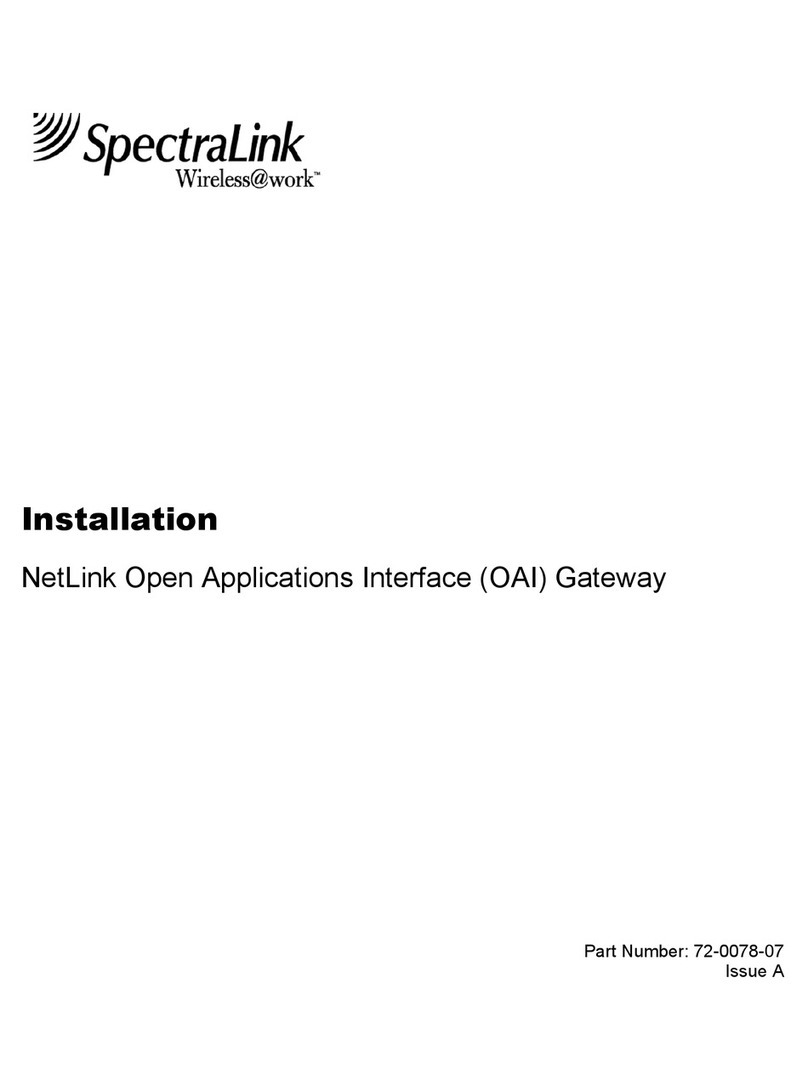
SpectraLink
SpectraLink MOG600 Installation
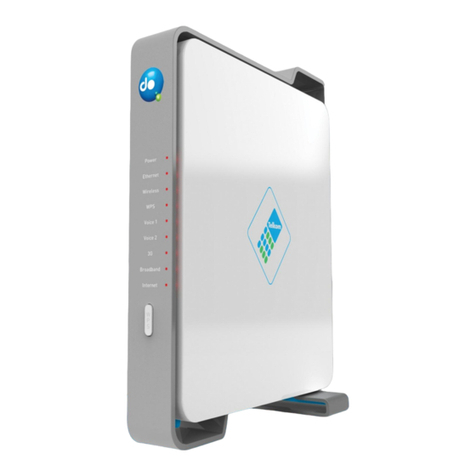
Pace
Pace Telkom 921VNX user manual
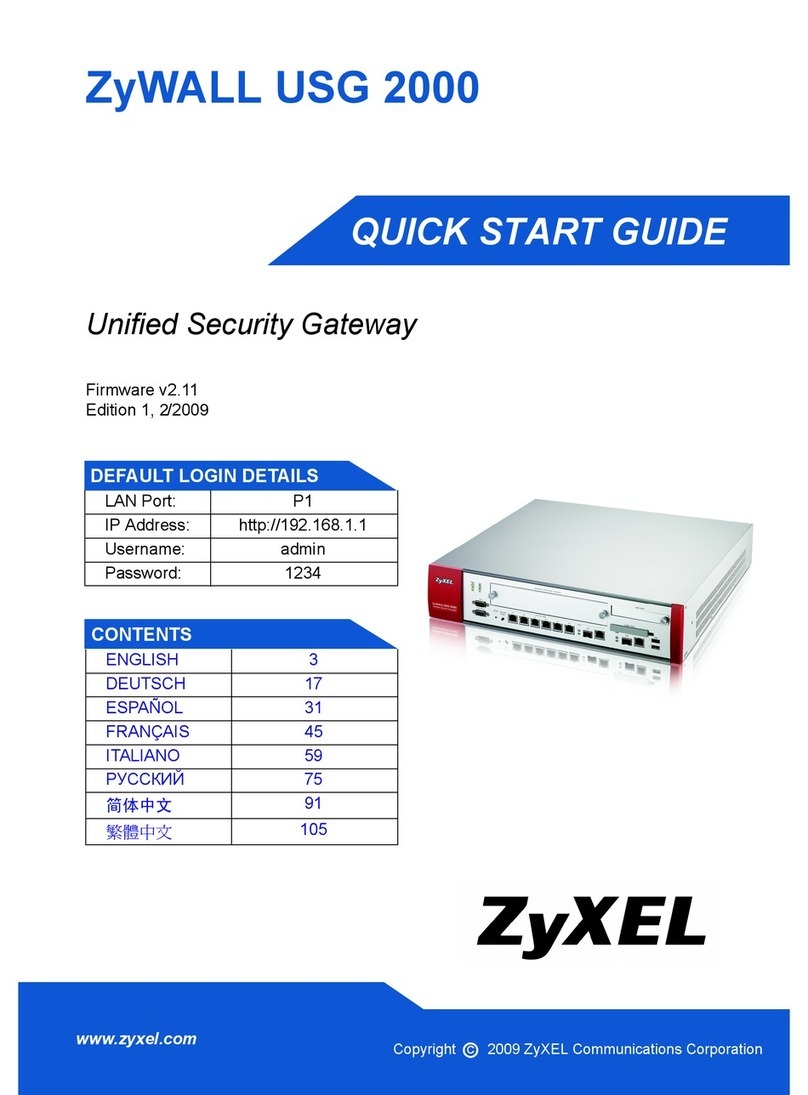
ZyXEL Communications
ZyXEL Communications ZyWALL USG 2000 quick start guide
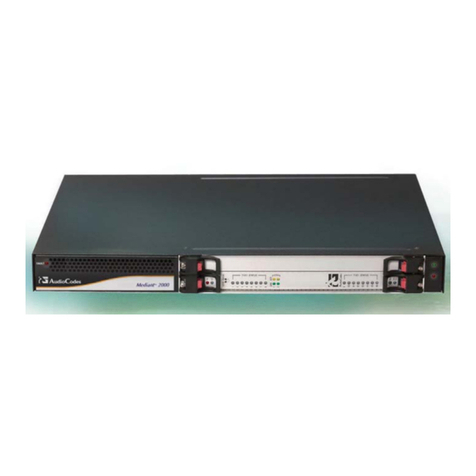
Nortel
Nortel Mediant TP-1610 SIP user manual

Atlantic broadband
Atlantic broadband Hitron CODA4589 Instruction guide

Nomadix
Nomadix AG 2400 quick start guide
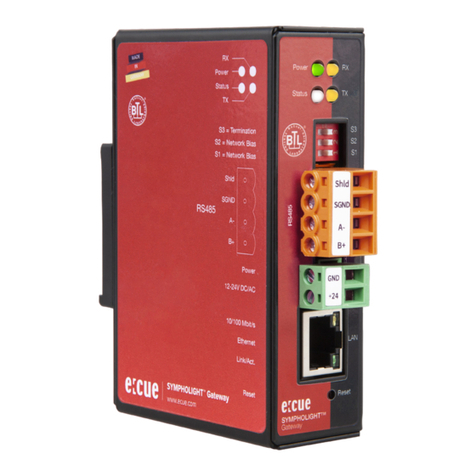
ECUE
ECUE OSRAM SYMPHOLIGHT AM476230031 Instructions for use

Actility
Actility ThingPark Partner installation guide

Market Central
Market Central 6100924-SC instruction manual
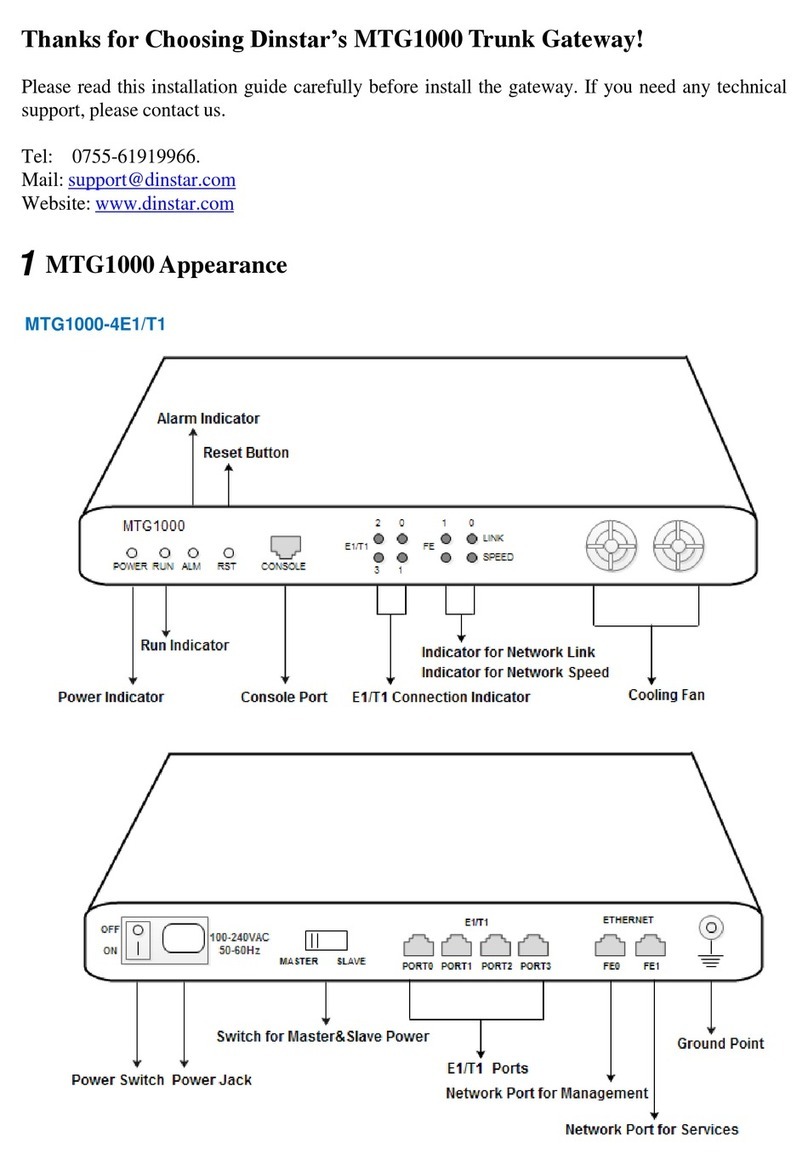
Dinstar
Dinstar MTG1000-4E1/T1 manual

Digi
Digi ConnectPort X4 installation guide
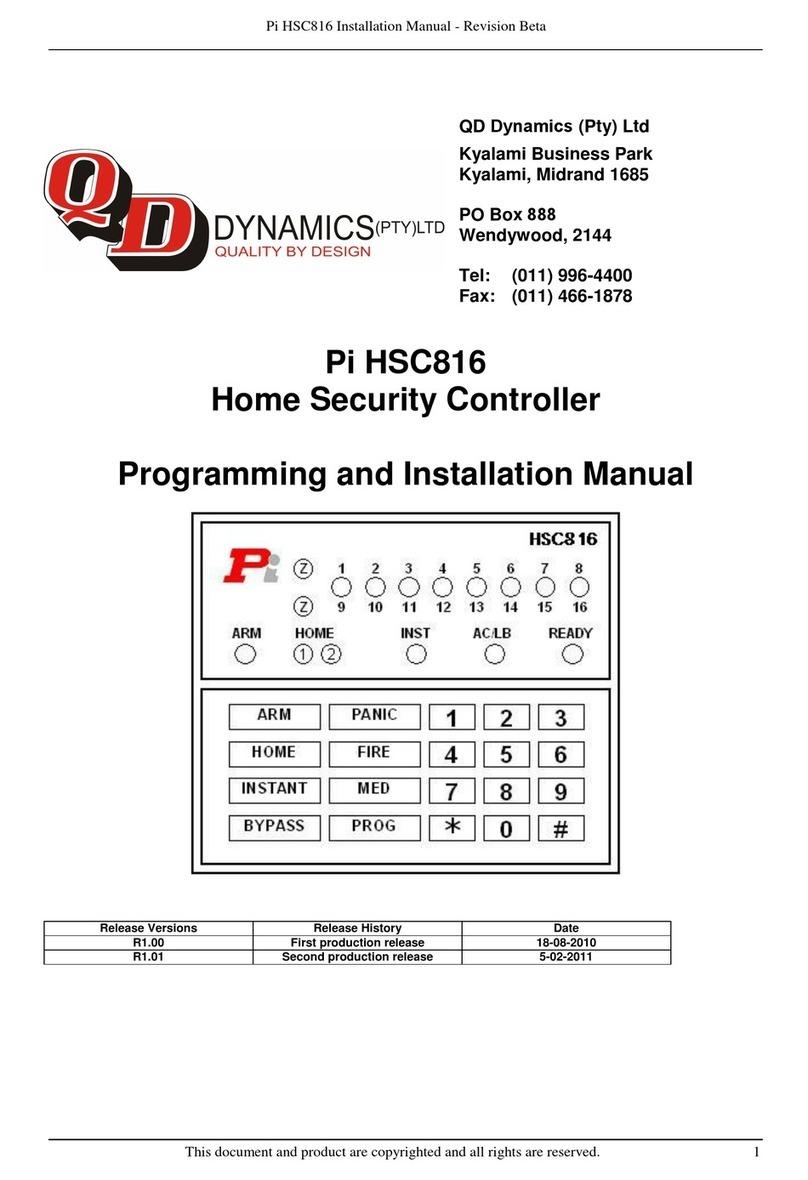
QD Dynamics
QD Dynamics Pi HSC816 Programming and installation manual
